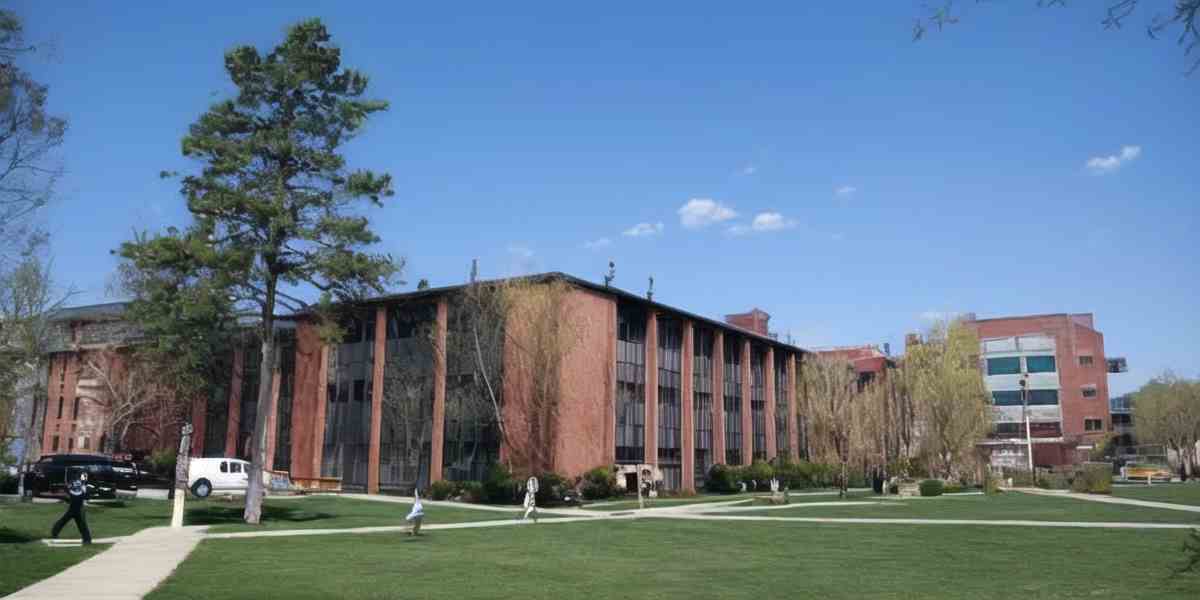Wilkes University
2024 USNews Best Colleges Ranking: 269(↓35) (Click for schools/majors ranking)
Abbreviation/Alias: Wilkes
School Characteristics: Private, non-Profit (4-Years)
Calendar systerm: Semester
Religious Affiliation: Not applicable
School Chief: Greg Cant (President)
Website: https://www.wilkes.edu/; Phone: 5704085000
Location: 84 West South Street, Wilkes-Barre, PA, 18766

Wilkes University Important Facts
Wilkes University Degrees and Majors
Wilkes University Ranking and Admission
Wilkes University Admission Score Requires
*Numbers at left represent SAT/ACT submitting percentage, numbers on blue blocks represent 25%-75% admission scores
**Drag green block to check data for different years, click blue block to check scores trends
Wilkes University Students Diversity
Wilkes University Students Age Distribution
Wilkes University International Students Trends
Wilkes University Campus and Safety
Nearby Top Colleges
Campus Safety
Reference
- Wilkes University Official Website
- USNews Best Colleges Ranking
- USNews Bset Global Universities Ranking
- THE World University Ranking
- QS World University Ranking
- ARWU World University Ranking
- US Department of Education College Scorecard
- National Center for Education Statistics
- Forward Pathway US College Ranking Database
 Wilkes University Important Facts Trends
Wilkes University Important Facts Trends
 Wilkes University degrees/majors
Wilkes University degrees/majors
Wilkes University major details
*Depends on whether majors have graduates in 2022 or not, Yes / No
**Move mouse on can check deitaled graudates number, click for major detailed information
***Due to privacy policy, graduate salaries are not shown for some majors that has few gradautes
| Major | Graduate Salary | Under | Master | Doctor |
|---|---|---|---|---|
| Pharmacy. | $127,945 | |||
| Registered Nursing/Registered Nurse. | $72,957 | |||
| Nursing Practice. | $72,957 |
| Major | Graduate Salary | Under | Master | Doctor |
|---|---|---|---|---|
| Business Administration and Management, General. | $58,133-$75,368 | |||
| Logistics, Materials, and Supply Chain Management. | $58,133-$75,368 | |||
| Accounting. | $69,557 | |||
| Entrepreneurship/Entrepreneurial Studies. | - | |||
| Finance, General. | - | |||
| Hospitality Administration/Management, General. | - | |||
| Marketing/Marketing Management, General. | $57,389 |
| Major | Graduate Salary | Under | Master | Doctor |
|---|---|---|---|---|
| Bioengineering and Biomedical Engineering. | - | |||
| Electrical and Electronics Engineering. | - | |||
| Environmental/Environmental Health Engineering. | $64,662 | |||
| Mechanical Engineering. | $73,078 |
| Major | Graduate Salary | Under | Master | Doctor |
|---|---|---|---|---|
| Liberal Arts and Sciences/Liberal Studies. | - |
| Major | Graduate Salary | Under | Master | Doctor |
|---|---|---|---|---|
| English Language and Literature, General. | - | |||
| Creative Writing. | - |
| Major | Graduate Salary | Under | Master | Doctor |
|---|---|---|---|---|
| Biology/Biological Sciences, General. | $60,789 | |||
| Biochemistry. | - | |||
| Neuroscience. | - |
| Major | Graduate Salary | Under | Master | Doctor |
|---|---|---|---|---|
| Psychology, General. | $41,972 |
| Major | Graduate Salary | Under | Master | Doctor |
|---|---|---|---|---|
| Criminology. | - | |||
| International Relations and Affairs. | - | |||
| Political Science and Government, General. | - | |||
| Sociology, General. | $39,205 |
| Major | Graduate Salary | Under | Master | Doctor |
|---|---|---|---|---|
| Speech Communication and Rhetoric. | $49,620 | |||
| Digital Communication and Media/Multimedia. | - |
| Major | Graduate Salary | Under | Master | Doctor |
|---|---|---|---|---|
| History, General. | - |
| Major | Graduate Salary | Under | Master | Doctor |
|---|---|---|---|---|
| Computer and Information Sciences, General. | - |
| Major | Graduate Salary | Under | Master | Doctor |
|---|---|---|---|---|
| Chemistry, General. | - | |||
| Geology/Earth Science, General. | - | |||
| Physics, General. | - |
| Major | Graduate Salary | Under | Master | Doctor |
|---|---|---|---|---|
| Mathematics, General. | - |
| Major | Graduate Salary | Under | Master | Doctor |
|---|---|---|---|---|
| Engineering/Industrial Management. | - |
| Major | Graduate Salary | Under | Master | Doctor |
|---|---|---|---|---|
| Environmental Science. | - |
| Major | Graduate Salary | Under | Master | Doctor |
|---|---|---|---|---|
| Drama and Dramatics/Theatre Arts, General. | - |
| Major | Graduate Salary | Under | Master | Doctor |
|---|---|---|---|---|
| Spanish Language and Literature. | - |
 Wilkes University Schools/Majors Ranking
Wilkes University Schools/Majors Ranking
Under Ranking (2024)
Grad Ranking (2025)
*Rankings have been updated to 2025USNews schools/majors ranking, rankings are for reference only
*numbers in bracket represent rankings change compare to last version
 Wilkes University Varsity Athletes
Wilkes University Varsity Athletes
| NCAA Division III with football | MEN | WOMEN |
|---|---|---|
| Football | 120 | - |
| Soccer | 39 | 34 |
| Lacrosse | 41 | 24 |
| Ice Hockey | 33 | 18 |
| Wrestling | 44 | - |
| Baseball | 35 | - |
| Basketball | 16 | 17 |
| Softball | - | 30 |
| Volleyball | 13 | 17 |
| Cross Country | 11 | 18 |
| Golf | 14 | 11 |
| Tennis | 12 | 8 |
| Field Hockey | - | 19 |
| Swimming | 10 | 4 |
| NCAA Division III with football | MEN | WOMEN |
|---|---|---|
| Football | 118 | - |
| Soccer | 38 | 25 |
| Lacrosse | 32 | 21 |
| Ice Hockey | 30 | 20 |
| Wrestling | 35 | - |
| Baseball | 34 | - |
| Basketball | 18 | 16 |
| Softball | - | 27 |
| Volleyball | 13 | 14 |
| Swimming | 15 | 9 |
| Golf | 13 | 9 |
| Track and Field, X-Country | 12 | 10 |
| Tennis | 11 | 9 |
| Field Hockey | - | 17 |
| NCAA Division III with football | MEN | WOMEN |
|---|---|---|
| Football | 107 | - |
| Soccer | 35 | 31 |
| Lacrosse | 29 | 23 |
| Ice Hockey | 30 | 20 |
| Baseball | 37 | - |
| Basketball | 15 | 18 |
| Volleyball | 13 | 17 |
| Wrestling | 27 | - |
| Track and Field, X-Country | 15 | 10 |
| Swimming | 15 | 9 |
| Golf | 9 | 12 |
| Field Hockey | - | 21 |
| Softball | - | 20 |
| Tennis | 11 | 9 |
| Rodeo | - | - |
| Equestrian | - | - |
| Bowling | - | - |
| Beach Volleyball | - | - |
| Badminton | - | - |
| Archery | - | - |
| Other Sports | - | - |
| Sailing | - | - |
| Water Polo | - | - |
| Table Tennis | - | - |
| Weight Lifting | - | - |
| Track and Field, Outdoor | - | - |
| Track and Field, Indoor | - | - |
| Team Handball | - | - |
| Synchronized Swimming | - | - |
| Swimming and Diving | - | - |
| Squash | - | - |
| Skiing | - | - |
| Rowing | - | - |
| Rifle | - | - |
| Gymnastics | - | - |
| Fencing | - | - |
| Diving | - | - |
| All Track Combined | - | - |

 Wilkes University Important Facts Trends
Wilkes University Important Facts Trends
















































































































































































































































































































































































































































